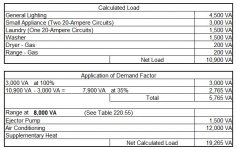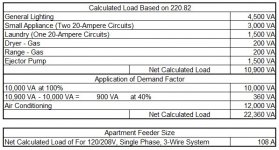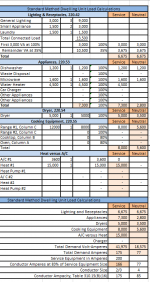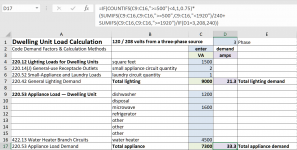You are correct. I took another look this morning and I was the one that was incorrect.
I based the statement on rounding the final number. It came out to .5 in this case you can round up not drop it. NEC: 220.5 (B)
22360/208=107.5
Sorry
You ask in your question.
"But I was wondering if there is
any factors I can use for the Ejector Pump or Air Conditional System
to lower the load."
Do you have the name plate of the AC unit. That may help reduce the load. To me it seams high for
1500 SF house.
Now for some fun I see you like spreed sheets. On the AC load you can use name plate or other information to get you there. I always prefer name plate however we seldom get that information in time. What one can do is use some basic math. In your example you used 12000 VA or 57.69 amps. It seam high for a new multifamily unit. If it is name plate well that is what you use. If was a guess well there may be a better way. sometimes in the field we have to take an educated guess due to the HVAC contractor being vague. For your spreed sheet you can use Amps=BTU/((SEERx.875)x Volts). Base your BTU on 20 per sq ft. Use a seer rating based on new equipment and stats energy code. For this we can use 14 SEER. Then we can use a zone area. The number below are for Zone 1&2 (hot)
Single Phase
| House sq ft | 1500 | | | MCA | | |
| Zone | 1.25 | Ton | Amps | Amps x 1.25 | VA | KVA |
| Btu | 37500 | 3.125 | 14.71743 | 18.39678 | 3826.531 | 3.826531 |
| SEER | 14 | | | | | |
| Volts | 208 | | | | | |
| | | | | | |
| House sq ft | 1500 | | | MCA | | |
| Zone | 1.25 | Ton | Amps | Amps x 1.25 | VA | KVA |
| BTU | 37500 | 3.125 | 14.71743 | 18.39678 | 3826.531 | 3.826531 |
| SEER | 14 | 3.5 | 16.48352 | 20.6044 | 4285.714 | 4.285714 |
| Volts | 208 | | | | | |
A side note: Using this calculation to compare to name plate for a 208/230 name plate use 197 for volts.
| House sq ft | 1500 | | | MCA | | |
| Zone | 1.25 | Ton | Amps | Amps x 1.25 | VA | KVA |
| BTU | 37500 | 3.125 | 15.53921 | 19.42401 | 3826.531 | 3.826531 |
| SEER | 14 | 3.5 | 17.40392 | 21.75489 | 4285.714 | 4.285714 |
| Volts | 197 | | | | | |
A side note: using this calculation to compare to name plate for a 208/230 name plate use 197 for volts.
I would say you could cut your AC VA load in half unless its name plate. 6000/208=28.85 x 1.25 =35.31 #8, 40 amp breaker@60c
"Do I need to increase the Small Appliance since there is a Fridge, Microwave and Hood?"
I do not see this in your calculations. If added to your standard calc using 220.53 you could use 75% for four or more.
Using all available information will yield a good answer.
Again Sorry about the .5







